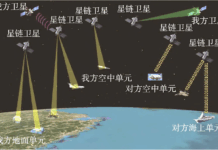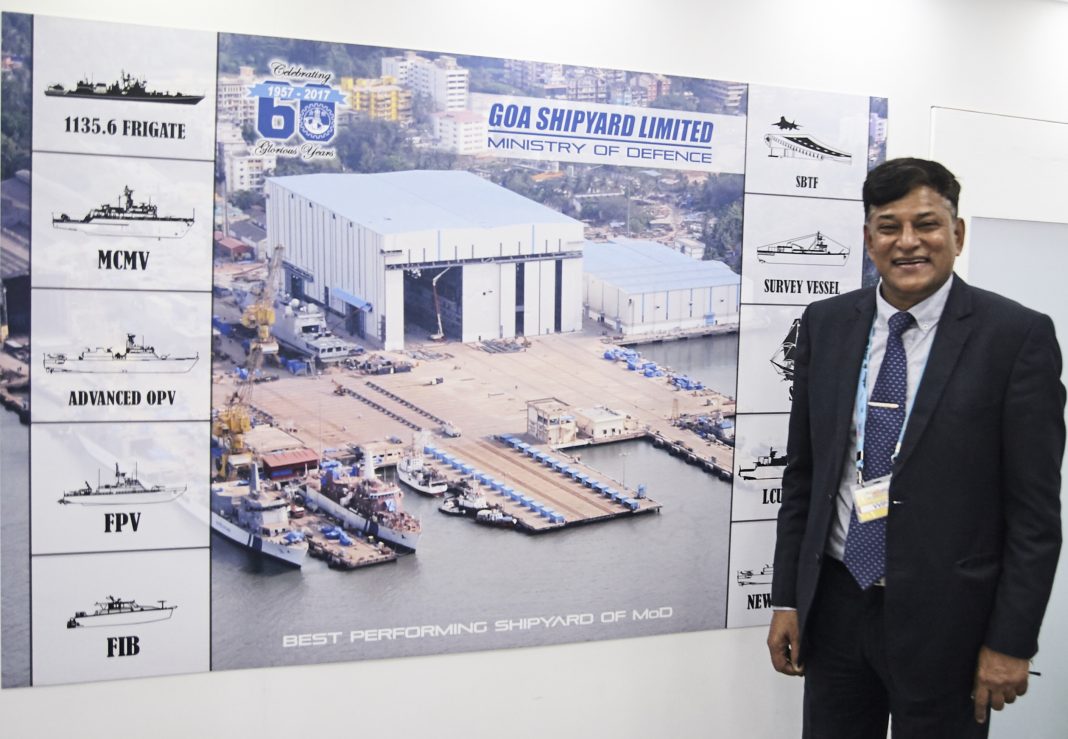Goa Shipyard Limited (GSL) was adjudged the ‘Best Performing Shipyard’ by India’s Ministry of Defence (MoD) for the financial year 2016-17. In the last two years, it has also delivered the highest gross tonnage for any shipyard in India and is all set to graduate to building 1135.6 Class frigates in collaboration with Russia. GSL is also the nominated yard for executing the Indian Navy’s Mine Counter Measures Vessel (MCMV) project that is expected to be worth about Rs 32,000 crores. Delhi Defence Review’s Editor-in-Chief, Saurav Jha , caught up with Rear Admiral Shekhar Mital (retd.), NM, who is presently Chairman & Managing Director of GSL, on the sidelines of Defexpo 2018 for a brief chat about GSL’s current and future programs.
Saurav Jha (SJ): Please tell us a bit about the progress made by the price negotiation committee (PNC) for the two 1135.6 Class frigates that are to be built by your shipyard in collaboration with the United Shipbuilding Corporation (USC) of Russia?
Rear Admiral Shekhar Mital (SM): Basically, these are the big projects; and going by the size and complexity of these projects you would note that the price negotiations are also quite complex and are held in two stages or parts. The first is between the government—I mean, the Ministry of Defence (MoD)—and the Russian side because part of the materiel will come from the Russians. Along with the materiel, we’ll also get transfer of technology (ToT) from the Russians. So that is one part of the price negotiations. The second part of the price negotiations is what will be held between us and the Indian Navy for the final contract.
I am happy to reveal, that the first part is progressing very well. MOD and the Russians have met twice in a formal PNC setting already. The third round of PNC meetings between them will be held from April 13 onwards. So we are all hopeful of seeing an agreement being reached on the price between the MOD PNC and the Russian side. Thereafter, in the second part, PNC meetings will be held between us and the Navy/MOD. We have submitted price quotations and have received a first round of observations from the PNC, to which we have already replied. So that should also move forward quickly. The Government has decided that the outcome of both PNC stages and indeed the contract for all four ships (i.e including the two 1135.6 frigates that will be directly imported from Russia),will go to the Cabinet Committee for Security (CCS) as a single case for consideration. So it could be said that the entire case is moving quite rapidly. We expect the case will be forwarded by MOD for CCS sanction in another couple of month’s time.
SJ: Would you be willing to comment on the total value of the order for the two 1135.6 frigates?
SM: I think it is a little premature to comment on this because it is under price negotiation at the moment. I think we should leave it at that.
SJ: As far as your MOU with USC is concerned, what all is involved, in terms of the materiel that will come from there and transfer of technology?
SM: Typically, what happens is that the entire materiel is divided into three categories. The first category relates to what we are going to get from Russia. And the second category is buyer nominated equipment (BNE), where the buyer (i.e the Indian Navy in this case) decides and tells us to buy certain types of equipment. Now the aim of this project is to see as to how the level of indigenization can be made really high. So between the Navy and us, we have done this rigorous exercise wherein we have identified almost 50 types of equipment in the BNE category. The third category is buyer furnished equipment (BFE), and between BNE and BFE, we have identified over 50 types of equipment which will be sourced locally from India to give a fillip to the ‘Make in India’ program. These will not just be Russian ships, but will carry a large number of Indian systems.
SJ: So given that objective, what percentage of the total value of these ships will be contributed by indigenous sources?
SM: You can say broadly, about 50 percent will be indigenous.
SJ: 50 percent?
SM: Yes, but it should also be kept in mind that it will all depend on the final PNC price that is negotiated by the Government with the Russians.
SJ: Given that until now, the largest ships ever built by GSL have been 105 metre (m) class offshore patrol vessels (OPVs), how is the yard preparing itself for undertaking the construction of frigate class vessels?
SM: Please realize that ship complexity is not decided by the size of the ship in question. Ship complexity is decided by its payload, its capacity, and the capability that has been put into the ship. We have made missile boats in the past, and these missile boats have the same gas turbines and every possible type of weapon. They were very densely packed platforms. More than that, say in the last year itself, we delivered 12,000 tonnes of gross tonnage and that was the highest in the Indian shipbuilding industry. The year before that we had delivered about 8,000 tonnes. Again, that was the highest in the Indian shipbuilding industry for that year. In the last 4 years, we have delivered 23 ships, that too is the highest number delivered by any shipyard in the Indian shipbuilding industry. We have reduced the lead time. You mentioned about the OPVs. You know, everyone ‘says’ OPV, but you must note that OPVs can be right from 75 m in length to up to 105 m. Here at GSL, we make some of the most advanced OPVs which are also the biggest in size, displacing some 2500 tonnes. The naval OPVs in particular have a very extensive weapons package. This includes your main mounting, which is a 76.2 mm the Oto Melara gun, the AK-630 for air defence, and also an EW system. You name an equipment that is required, and it is there.
SJ: Will you talk a bit about the Sri Lankan OPV program, i.e the export order that you recently executed?
SM: You will be happy to know that we are the largest exporter of ships in India. Last year, our turnover from exports was Rs 610 crores or so, and this was around 40 percent of our total turnover. And the year before, it was Rs 400 crores, again about 40 percent of our turnover for that year. In three years time, our export value has grown from Rs 100 crores to Rs 600 crores. And the best part of the Sri Lankan project is, the project had become effective in 2014, and in 2018, we completed the project. You will not find in the history of Indian shipbuilding, that one has been able to conclude a project like this at this kind of pace.
SJ: What is the Sri Lankan experience with product support from GSL?
SM: See, the product support, as per the contract, I’m supposed to be positioning a dedicated group there—a dedicated team there, a guarantee cell there. But they are so happy with the operational performance, that they have said there is no requirement. Whatever defects are coming we have been able to sort them out over correspondence.
SJ: India recently extended a $100 million line of credit to Mauritius, to whom you have supplied two fast patrol vessels (FPVs) in the past. Do you see yourselves as beneficiaries of the new line of credit?
SM: We have supplied two 50 m long fast patrol vessels or FPVs, which against a rated speed of 35 knots, can actually move at a speed of 37 knots. We have completed the guarantee liability for the first FPV already. We have also supplied 11 fast interceptor craft for which too we have completed the guarantee liability with the Mauritius side. And there is not a single observation between us and them. With that sort of a relationship, and that sort of satisfaction, it is but natural that this $100 million is basically for a ship that we will be supplying to Mauritius. We are working with the Mauritius side. We have covered a whole lot of distance on this. We have finalized the design. We have met all their requirements. So I think you will hear a formal announcement in the due course of time.
SJ: Okay, so these were the various success stories of GSL. Now we have to talk about the seemingly ill-fated project—the MCMV program. Given the total value of the program, and the fact that you have gone back to Kangnam twice, what kind of a response has there been to the new expression of interest that has been floated for this project?
SM: Let me first correct you and give you my perspective when you say ‘ill-fated program’. Believe me, in the last four years, the maximum bandwidth, as far as the top management is concerned—including my time—has been spent on that project. And for any big project, or mega-project, the size of MCMV, the success of the project lies in seeing that everything is planned well. Whatever capabilities are required, you create those capabilities —whether in the form of hard capabilities—infrastructure, or in the form of soft capabilities, like training & recruiting manpower and gearing up for that.
Very happy to tell you, that along with the Navy, we have worked very extensively to finalize the detailed design of every compartment in MCMV, which has now been done. Along with the Navy, we have also finalized the equipment specifications. We have done, you know, a number of vendor development programs, wherein we brought in almost thirty Korean OEMs, 26 Korean OEMs to be exact, for back-to-back tie-ups with Indian firms. So a full load of work has gone in. We are absolutely ready to sign, the moment we finalize. Please appreciate that the technology for the MCMV, that is what has been decided upon, is in the domain of the Navy. The Navy tells us about what kind of technology they want. In this case, it was a single-skin non-stiffened hull. And for that technology, there are only two vendors. You are aware of it. One is Kangnam, the other is Intermarine. We are pursuing with Intermarine, we are hopeful. We pursued them the last time over as well, and we’re pursuing them again. If both the vendors are there, we will move ahead. If both vendors are not there, we will go to the government/ MoD and they will take a call.
Feature Photo: GSL CMD RADM Shekhar Mital (Retd) standing next to GSL’s portfolio. Credit: Sriram Thiagarajan
Interview transcribed by Payal Nagpal
© Delhi Defence Review. Reproducing this content in full without permission is prohibited.
































